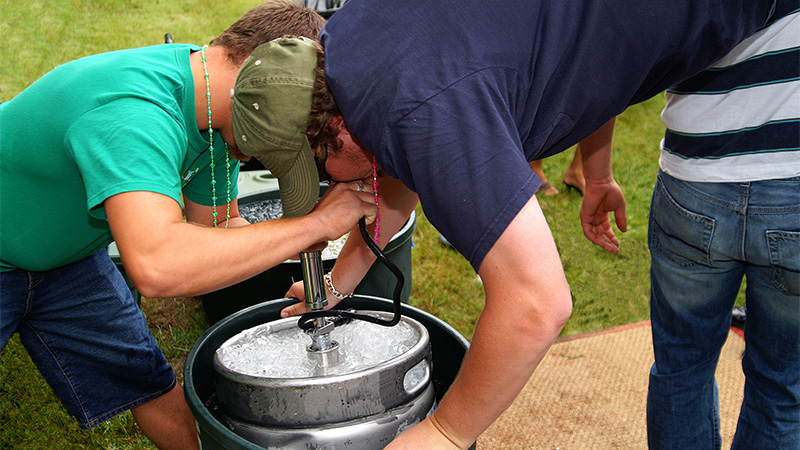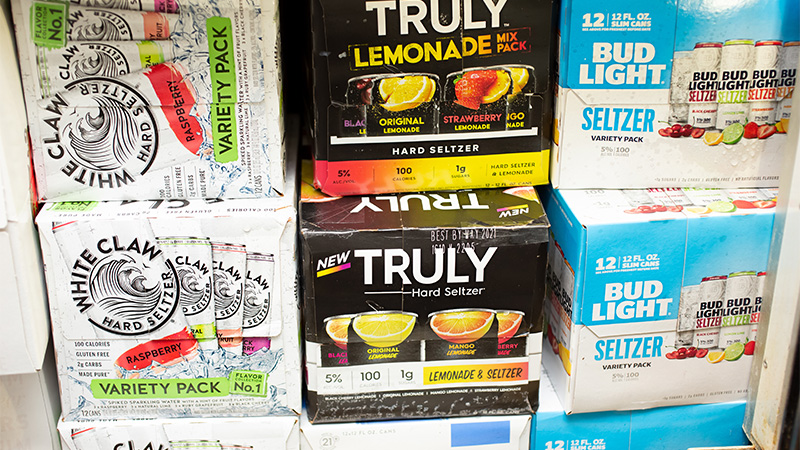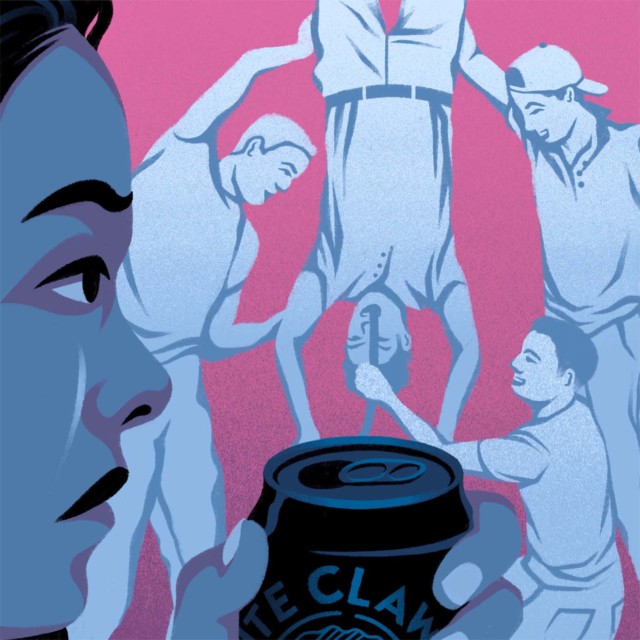There’s a scene in “PCU,” the seminal 1994 college coming-of-age flick, where Droz, played by a pre-“Entourage” Jeremy Piven, saves his off-campus flophouse’s big fundraising bash from a mob of malcontent meatheads with the soothing promise of cold, free-flowing keg beer. “We’ve got an L.A.-sized riot of thirsty men with no necks screaming for brew,” he says, snatching a pair of specialty faucet handles from his deadbeat housemates and smoothly tapping the half-barrels in front of him. As the CO2 hisses and the metal couplers lock into place, the bros behind him cheer. Crisis averted; beer delivered; party commenced.
I’ve been thinking about “PCU” a lot lately. Partly because it was loosely premised on the idea that “political correctness” was running amok on college campuses, a moral panic conservatives invented in the ‘90s that bears remarkable resemblance to the bad-faith “cancel culture” screeching lately in vogue with today’s right-wing wingdings. And partly because “PCU,” for all its campishness and cringe, harkens back to a glamorous era of collegiate consumption, when draft beer in plastic cups represented both the pinnacle of party refreshment and the social freedom of an uninhibited, no-parents lifestyle.
“The beer keg [is] as much a staple of college life as the all-nighter or the incompatible roommate,” wrote The New York Times in a 1991 story about administrative efforts to regulate the proliferation of half-barrel-fueled bashes on university campuses. “For some, particularly undergraduates, it represents independence and youthful exuberance, a rite of passage to the adult world, or, at the very least, the reason weekends were invented.”

Three decades later, everything has changed, and the college party landscape is no exception. There’s the coronavirus pandemic, certainly, and we’ll get to that. But broader trends are at play, too. Greek life’s life-of-the-party mythos, fueled by silver half-barrels of swill and burnished by films like “Animal House,” “Old School,” and “Neighbors,” has been marred by one grim scandal after another. College students are binge drinking less than they used to, and just generally drinking less, too. When they do drink, they have at their disposal a breadth of beverage alcohol beyond Droz’s wildest dreams — including, especially, hard seltzer. As one market researcher put it, while beer is still very popular among college drinkers, “hard seltzer has the momentum.”
But hard seltzer’s rise has been largely a canned affair; draft hard seltzer exists almost exclusively in commercial settings, and has yet to seep into the low-pile carpeting of America’s house party tradition. What, then, does the rip-roaring popularity of White Claw et al. portend for the venerable American institution of the college kegger? Positively a-bubble with curiosity, I set off to find out.
Draft on decline
The first thing you’ll discover when you try to find out how many college keg parties are thrown each year is that no one has any idea how many college keg parties are thrown each year. It’s a very specific, very squishy slice of sales data to try to track across hundreds of schools with different keg restrictions and 50 states with different keg-sale regulations. And the specter of illegality looms over it, besides. “Off-premise draft sales are small and not well covered by scan data, so it would be hard to get this information anyway, but you’re also fighting some willful ignorance,” says Michael Uhrich, the founder and chief economist at the industry consultancy Seventh Point Analytics, and the former chief economist of the Beer Institute, a trade group. “The industry isn’t exactly looking for ways to show how much of its volume ends up at parties that may be attended by underage drinkers. It would require some survey or audit work that nobody wants to pay for or even see if it was available for free.”
Zoom out beyond the hallowed halls of higher education, and you’ll see that draft beer sales have not fared well in recent years. National data from the Alcohol and Tobacco Tax and Trade Bureau shows that beer sales in barrels and kegs have declined every year since 2014. According to the National Beer Wholesalers Association, keg beer’s share of total U.S. beer volume dropped 40 percent — from 10 percent of beer’s overall volume share, to just 6 percent — between 2019 and 2020 alone. Canned beer volumes grew 7 percent during the same period.
Again, these figures aren’t specific to college keg parties; they include the draft beer sold at restaurants and bars, too, which, compared to the volume of beer consumed at keggers, is likely just a drop in the bucket. But it does suggest that today’s drinking public might not be putting the premium on draft beer it used to.
The pandemic problem
Overall, these limited sales data indicate a directional shift away from draft beer, and that shift bodes well for hard seltzer, most of which is currently sold in cans. But while those figures are about as transparent as a red Solo cup, speaking to current and former students made one thing White Claw clear: the coronavirus pandemic made crowd-drawing keg parties both harder to pull off and less appealing to attend.
“I did see one kegger last year, and [I had] an instant reaction to it being a super spreader, a bad type of vibe,” says Michelle*, 21, a rising senior at Indiana’s Ball State University. “When you’d see videos of people doing keg stands from the same tap during a pandemic, it’s like ‘girl, where’s your head at?’” (Speaking of videos, searching for tags like #kegger and #kegstand on TikTok, Gen Z’s preferred social media platform, will return countless videos depicting keg parties, though most appear to have been filmed at backyard hangouts and small gatherings of adults, not “PCU”-style college keggers.)
Megan Brenneke, a 23 year-old who graduated from Mizzou in 2020, points out another pandemic-related mark against the kegger. “You have to have a lot of people to drink a keg,” she says. As the pandemic hit last year, some college students came under harsh criticism for flouting public health advisories to throw no-guest-list blowouts, but there were plenty of kids who “weren’t having that kind of party” says Brenneke (and presumably weren’t comfortable attending one, either).
That’s not to say the pandemic has permanently turned public opinion against keggers, or that everyone will be henceforth turned off by their unsanitary drinking conditions. Filling a cup of Keystone from the same tap you just watched an upside-down bro wrap his lips around for 10 Mi-ss-iss-ip-pi and not feeling skeevy about it has always required a uniquely undergraduate cognitive dissonance. Though university administrations and even law enforcement around the country have taken efforts to curb keg parties to deter the spread of the virus, some students I spoke with believe a return to half-barrel normalcy is inevitable.
“The social scene is basically under attack [due to the pandemic], and probably rightfully so because college campuses can be a nightmare for Covid spreading” says Steven, 21*, a junior at Bucknell, but prior to the pandemic, “kegs would dominate” the scene at the school’s vaunted Super Saturday day parties. “I fully expect, once Covid is kind of done, that we’ll get back to the Super Saturdays that Bucknell is known for,” kegs and all.
A growing pre-game and party preference
When Brenneke first got to Mizzou in 2016, she hardly ever came across a hard seltzer. But by midway through her undergraduate career, White Claw had touched down on campus. “White Claw was all I heard about for a long time, and then there started to be so many” hard seltzer options, Brenneke, now 23 and a year removed from graduation, tells me. “I’ll pretty much exclusively drink hard seltzer. … I really didn’t drink beer at all until I graduated, so [hard seltzer] was my go-to for sure. It’s still pretty much all I drink.”

That timeline tracks with hard seltzer’s meteoric sales uptick in the U.S. Between 2016 and 2020, hard seltzer category revenues leapt from $41 million in 2016 to $2.5 billion in 2020, according to figures from market-research firm T4. It also aligns with the experiences of the half-dozen current or recently graduated college students from across the country I interviewed for this story. “I really didn’t drink them that much, or even know that much about them at all my freshman year, but second year they were there a lot,” says Katharine*, 22, who graduated from the University of Virginia earlier this year. “I have not seen a keg in awhile,” she continues. “Even in my sophomore year [2018-2019, so pre-pandemic], I don’t know if I did then, either.”
A recent study shows that while hard seltzer hasn’t replaced beer (kegged or canned) among college drinkers, it’s become a reliable go-to in key contexts. In a 2021 survey of 544 college students enrolled in two- and four-year schools across the country, the polling firm Generation Lab found that across four hypothetical occasions — ”casual drinking alone,” “casual drinking with a few friends,” “for pregaming,” and “at parties” — a consistent share of those drinkers preferred hard seltzer at each. Hard seltzer hovered between 13 and 16 percent; preference for other drinks like wine, beer, and liquor shots fluctuated wildly across occasions.
“Kegs weren’t really big at Boston College, even before the pandemic” says Kirf Olander, 22, who graduated in May 2021, so as hard seltzer became more popular, parties “really just changed from people bringing over cases of beer to people bringing over like 12-packs of seltzer.” This speaks to another innate challenge in pinning down good data — regional drinking habits, like legal and administrative regulations, tend to vary. Some schools have strong keg cultures, and others simply don’t.
(One exception I heard again and again: drinking games. “White Claw has completely changed my taste,” says Steven. “I don’t drink nearly as much beer unless I’m playing a drinking game. That’s really where beer still kind of dominates.”)
“I think the key is that hard seltzer has the momentum,” Cyrus Beschloss, Generation Lab’s founder, told me. He thinks it’s “insane” that the category is approaching parity with beer among college drinkers in just a few years on the market. “It seems to have a really, really pronounced floor [among college students], and we haven’t seen the ceiling yet.”
‘Kegs are kegs’
Generation Lab’s survey did not distinguish between draft and packaged beer, so again, it’s best to consider these data directionally, not absolutely. And while hard seltzer enjoys wide enthusiasm among college-aged drinkers, that doesn’t necessarily mean the kegger, much less beer itself, is destined to be blackballed from the frat party of history. Students I spoke with have a hard time imagining the former ever truly (ahem) displacing the latter for the simple reason that popular college value beer brands — Natural Light, Busch Light, Keystone, and the like — are much cheaper than premium FMBs.
“I’m a big beer guy,” says Tristan Jackson, 21, a senior at Indiana University. “I’m not a huge fan of the taste of it, but it’s as cheap as you can get.” While keggers weren’t a part of his drinking agenda at IU pre-pandemic, he sees beer as the more affordable volume option for kickbacks and other social gatherings anyway. (An analysis of per-case pricing by First Key, a beer industry consultancy, backs that up: The hard seltzer category averages $35 a case at retail, while sub-premium beer goes for just over $15 a case.)
At schools where kegs are popular, the savings compared to hard seltzer 12-packs can be even more significant. “I don’t think [hard seltzer will] ever replace kegs, just because when it comes to the financial perspective of it, it’s easier to just go in for a $60 keg than three cases of White Claw, which is like the same” cost, says David Halbert, 22, a Class of ‘21 grad from Rowan University “I like hard seltzers, but kegs are kegs. … They’re just so easy, and so simple. I don’t know how else to really say it.”
Like Halbert, Steven from Bucknell is dubious that kegs deliver cultural cachet to a party, but he agrees the value is undeniable. “Kegs are looked at as a better economic choice, but less as a ‘draw.’ … I think that still exists, but I feel like kegs are more of a practical way of saving money. … That’s how college kids now would look at it.”
Is price differential alone really enough to blunt hard seltzer’s takeover as the American co-ed’s drink of tomorrow, and to preserve the kegger’s canonical collegiate status? It’s hard to say just yet. But make no mistake, hard seltzers’ comparatively high cost is a deterrent for cash-strapped undergrads. “I’m a Truly girl, but if I’m at the bar my drink is different [because] I’m just not paying $5 for one seltzer,” says Michelle at Ball State University. “Not gonna lie, I went to the bar on Tuesday and I snuck a seltzer in my purse, then I dumped it in my cup when it was empty. So I don’t pay for it, but I might sneak them in.”
Keg or not, I think Droz would be proud.
*These students requested pseudonymity to be able to speak freely about drinking and parties without fear of retaliation from school administrators or damaged job prospects. Surnames have been withheld and some first names have been changed accordingly.
